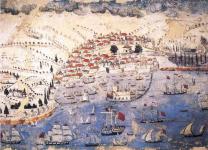

From the very beginning of the
ottoman invasion Cretans attempted to react against the conqueror, even not in
an organized way. Many of them found shelter inside the three fortresses that
still remained under Venetian rule, i.e. Gramvoussa, Suda and Spinalonga. Later
(after 1715) they resorted to the mountains and the monasteries. From there,
they attacked the enemy during the night. The Turks called them “hain”, which
means insidious, traitor. If captured, they suffered tremendous tortures and
faced a dreadful death.
In
1770 the first serious attempt of a rebellion against the Turks took place. At
the head of the movement was the rich ship-owner from the village of Sfakia
Ioannis Vlachos, better known as Daskalogiannis. The rebellion of
Daskalogiannis is another incident of the Greek revolt known as “the Orlov
Events”, that is the revolt encouraged by tsarina Ekaterina of Russia in which the brothers counts Orlov were
involved. Count Fyodor Orlov was an acquaintance of the travelled Ioannis
Vlachos, probably because of Emmanuel Benakis of Mani. He found himself in Mani
in 1769, ordered by Ekaterina to organize a revolt, in which many rebels from
Sfakia took part.
Counting
on the Russian aid, Daskalogiannis prepared a revolt in Sfakia, by gathering
weapon and supplies. On the other hand, the ottoman authorities have been
informed that a Russian fleet sailed from Gibraltar to Suda. The first reaction
of the Sfakians was the denial to pay the poll tax in the Easter of 1770. The
2000 revolted fighters moved against the neighboring areas of the county
Kydonia, probably in the 4th of April. The Turkish reaction was
immediate. 15.000 soldiers sieged Sfakia and attacked the village from three
different directions when the rebels refused to surrender. During that summer and
the following autumn the besieged resisted bravely. But when the Turks
plundered and burned the villages of the county and sold the women and children
for slaves (the wife and two daughters of Daskalogiannis as well), they were
forced to surrender and to sign a humiliating treaty (17th of March 1771),
under the promise for amnesty.
Nevertheless,
the Pasha of Candia, breaking the deal, captured Daskalogiannis and made him
flay alive. His companions from Sfakia were imprisoned in Kules (probably at
the eastern chambers of this very corridor), from where they managed to escape
three years later.
The
rebellion of Daskalogiannis was the first of a long series that were to follow,
proving the continuous struggle of Cretans to regain their freedom.
 | 6. The Great Castle (Kandiye) | |
|---|---|---|
 | 6.1 Crete during the Ottoman occupation | |
 | 6.2 Heraklion during the Ottoman period |